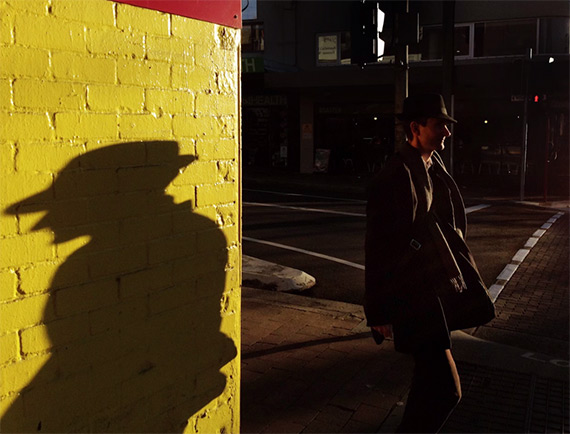When people talk about Sydney, they always talk about the light—the incredible Sydney light. Australian photographic artist Markus Andersen uses that light to create imagery. His canvas is the city streets where he sees the chaos of life and he makes order of it through his photography. This creative short documentary shows the process Andersen goes through to capture his images and how he thinks about his art:
Andersen specializes in documentary, street and conceptual bodies of work and his work has been exhibited in New York, Paris, Istanbul, Toronto, Sydney and the United Kingdom.
He loves photographing Sydney and spends much of his time on the streets looking for unique scenes, unpredictable moments.
“There has to be layering in the images, there has to be a story to tell, there has to be that one odd element that brings it out of the ordinary into something special.”
When he’s out shooting in Sydney, he travels by bus, ferry, or train. The moment he steps off the train or bus, he’s hit with the chaos of the streets, he lets the people envelop him and he shoots to make order out of that chaos.
“There’s life, there’s canyons of metal and steel and concrete, it’s like being sort of dropped into the belly of the beast.”
Andersen shoots both film and digital, but really likes film. At the moment he uses a Leica MP because it’s fully mechanical and designed to last forever. It’s great for photographing people and capturing instinctive moments of life.
He also uses a Hasselblad 503CW and says there’s something more discerning about the imagery. The camera isn’t fast so you need to slow down and be more thoughtful.
Andersen may prefer film, but he’ll shoot with anything. It doesn’t matter if it’s 35mm, 120 film or his iPhone, they are all tools to capture his images. His passion is street photography documentary because it’s unpredictable. The cameras just allow him to capture the unpredictable moments.
You can shoot for weeks on end and not get anything, but then that one really unique shot comes along where everything is there—the right light, right subject, right moment, it’s all there.
His advice: No matter what, don’t be afraid to push the button. You never know what you might get and something surprising might appear, so always take the shot.
He looks for depth and character in the image—spindly bare tree branches that cast long shadows on walls, street signs that add something to the scene, anything that adds that extra element.
“I love creating imagery, it’s the most important thing in the world for me.”
It’s not about becoming famous, he says, but the more successful you become, the more time you have to shoot. That’s what’s important, as opposed to having to find time between work and life.
Andersen is really passionate about his work and understands the importance of street photography. It’s a recording of a specific time and place. This is Sydney right now.
“If we lose this, then there’s no history.”
Like This Article?
Don't Miss The Next One!
Join over 100,000 photographers of all experience levels who receive our free photography tips and articles to stay current:











He’s one of those street photographers where it’s hard to figure out what the hype is. While he has many photos where the light is nice, there’s nothing much of interest in the vast majority of his photos. Most of them are of people just walking by. You’re not close enough to see anything expressive or of interest on their face or any interesting reactions among people or the environment. Anyone can stand in front of a striped awning and wait ten minutes for someone to walk by. Good street photography usually is able to capture the essence of both the surroundings (which he’s got) and the people (which he fails at.) Vivian Maier’s style is what I consider quintessential street photography. Timeless yet caught in a time capsule, with a perfect balance between interesting people and interesting environments.
He says a moment in a city’s history should be documented. I agree and this is a wonderful side effect of street photography, but he is utterly failing at that if you look at his photo and can’t tell whether it’s 1915 or 2015.